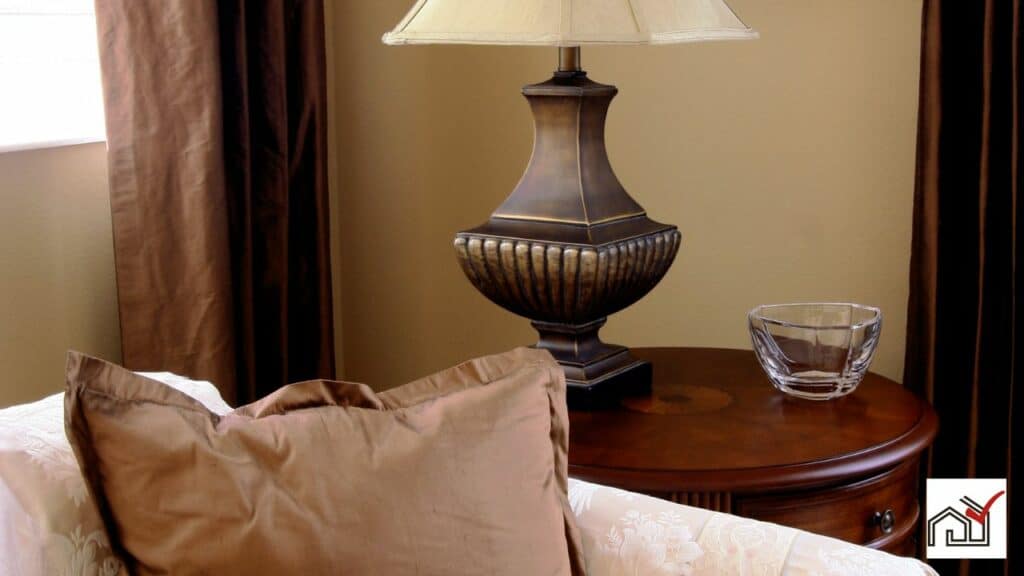Choosing the right lamps for end tables is essential for both functionality and design. Consider the lamp and table sizes to ensure they are proportional.
The lamp style should match the room's decor. The lampshade should be sized and positioned for optimal lighting and comfort.
Color and texture should also be considered to enhance the room's atmosphere.
Assessing Table and Lamp Proportions
When choosing a lamp for an end table, it's important to match the lamp's height to the table to achieve a balanced look. The lamp should generally be taller than the table, ideally between 30-36 inches tall. This height range ensures that the light is functional and contributes to the room's overall design.
The top of the lamp, including the base and shade, should be at the eye level of someone sitting down to avoid glare and ensure comfort. The size of the lampshade is also crucial; it should be proportional to the table's height and not extend beyond the edge of the table to prevent a cluttered look and reduce the risk of accidents.
Additionally, the lamp's size should be appropriate for the end table, the nearby furniture, and the room's size. A lamp that is too tall can overwhelm a small space or a small piece of furniture, while a short lamp may be inconspicuous in a large room or next to a big sofa. The height of both table and floor lamps should be considered in relation to the room's overall proportions for a harmonious interior design.
Considering Lamp Styles and Themes
When selecting a lamp, it's important to match its style and design with the room's decor. A table lamp serves as both a light source and a decorative item, influencing the room's overall look. Modern rooms benefit from lamps with simple lines, while traditional spaces may suit lamps with detailed, classic designs.
The lamp shade is key in setting the room's mood. Shades come in various shapes, colors, and patterns, affecting the theme. A bright shade can be a centerpiece, whereas a neutral one can blend with the room's decor. The shade's texture can also connect with other room elements, such as matching fabric patterns or reflecting accent pieces.
Choosing a table lamp involves balancing its practical use with its aesthetic contribution. Lamps can range from industrial to rustic, contemporary to vintage, depending on personal preference and the room's style. The ideal lamp will fulfill its lighting function while complementing the room's decor.
Understanding Lighting Needs
Selecting the right lamp size for an end table is essential for both functionality and aesthetics. The lamp should provide adequate light for tasks such as reading, while also fitting well with the room's decor.
The height of the lamp should match the end table to maintain visual balance. When sitting, the lampshade should be at eye level to prevent glare and provide comfortable lighting. The lamp's size should not overpower the table or extend beyond its edges, ensuring safety and a cohesive look.
Both the base and shade's diameters must be proportional to the table size, ensuring the lamp is neither too large nor too small.
Selecting the Right Lampshade
Choosing the correct lampshade is important for both light diffusion and decoration. The lampshade should match the size of the lamp base and fit with the room's decor. The shade's width should be at least as wide as the lamp base's widest part. The shade's height should be 40% to 60% of the lamp's total height.
The bottom of the lampshade should be at eye level when seated to prevent bulb glare. This is especially important for lamps on end tables near seating. To avoid overheating, leave 2 to 3 inches of space between the bulb and the shade.
Balancing Colors and Textures
When selecting a lamp for your end table, consider how it will fit with the room's colors and textures to create a balanced look. The lamp should complement the room's decor and the end table, which typically sits next to sofas, beds, or chairs.
Choose a lamp that matches the end table's hues and materials. For example, a wooden end table may look good with a ceramic base lamp that has similar warm tones or a contrasting metal base for variety. The lampshade should also fit the room's color scheme without overpowering it. A neutral shade can balance a colorful room, while a patterned shade may stand out in a simpler setting.
Mixing materials can also add depth. A glossy lamp can contrast well with a matte end table, and a textured lamp base can stand out against a smooth surface.
Selecting a lamp that complements the room's existing colors and textures will create a cohesive and welcoming space. It's important to choose a lamp that is both functional and enhances the room's overall design.
Placement and Functional Considerations
Placement and Functional Considerations
When positioning a lamp on an end table, it is essential for both its appearance and functionality to consider the height relative to the user's eye level for effective lighting. The ideal height for a lamp on an end table, particularly beside a bed, is between 30-36 inches. This height ensures the lamp is slightly taller than the table, providing balanced proportions and preventing the light from being too low or too high.
The lampshade should be at the eye level of a person sitting next to it to offer proper lighting for reading or other activities without eye strain. The bottom of the shade at eye level helps diffuse the light comfortably.
Additionally, a well-placed lamp is part of a layered lighting approach, which includes various light sources like ceiling fixtures and wall lights, to allow for adjustable room ambiance.
Lastly, the lamp should fit the end table in size, not dominating or being too small, to maintain functionality and room aesthetics.





